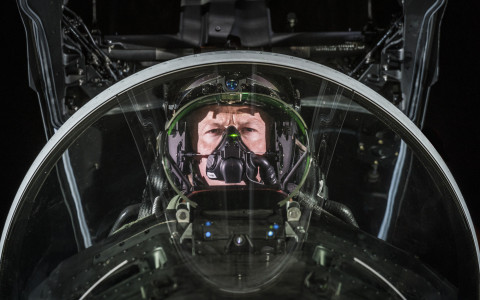LONDON--(BUSINESS WIRE)--BAE Systems has begun night trials on the Striker® II helmet-mounted display (HMD), the company’s most advanced fighter pilot helmet, to evaluate its digital night vision capability. Successful trials will lead the way to a fully integrated digital night vision helmet replacing the need for traditional analog night vision goggles.
Developed and tested by BAE Systems, Striker II is a fully digital solution that provides today’s combat pilot with exceptional night vision and target tracking technology. BAE Systems has begun evaluating the digital night vision capability through a series of night flight trials.
“Striker II has a high-definition, lightweight night vision camera which translates information and displays it on the helmet’s visor. This removes the need for heavy night vision goggles which increase g-force pressures on the head and neck, limiting the pilot’s maneuverability in the cockpit,” said Peter Kosogorin, test pilot for BAE Systems. “The helmet provides a clear and accurate visual display and a seamless transition from day to night, eliminating the need to manually configure and adjust night vision goggles.”
BAE Systems will continue to evaluate the helmet’s integration with Typhoon aircraft in another series of flight trials later this year.
“The second set of trials is the next step in the flight test program to prove Striker II offers true ‘plug and play’ compatibility with the Typhoon and builds upon the initial trials to further evaluate the digital night vision capability,” said Chris Colston, business development director at BAE Systems.
Striker II also includes a cutting-edge tracking system that ensures the pilot’s exact head position and the aircraft computer system are continuously in sync, reducing problems common to other HMD’s. The tracking system in Striker II eliminates any delay in determining where the pilot is looking and can therefore perfectly position symbology onto the visor. The results are high-precision target tracking and engagement, as well as superior situational awareness and mission effectiveness.
BAE Systems provides cutting-edge avionics systems and advanced cockpit technologies for both military and commercial aviation platforms. Its display systems offer fast-jet pilots a real-world view of terrain, allowing them to see and avoid all obstacles in their flight path, even when visibility outside the aircraft is limited. The company’s vast industry experience, solid partner commitment, and world-class solutions are relied upon by leading aerospace companies around the globe.
For imagery, please visit: https://resources.baesystems.com/?c=5866&k=12c8a51685




